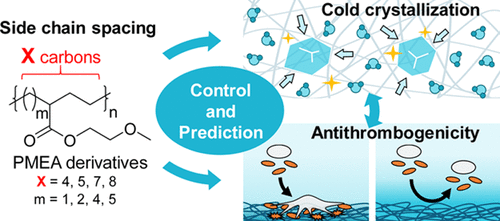当前位置:
X-MOL 学术
›
Macromolecules
›
论文详情
Our official English website, www.x-mol.net, welcomes your feedback! (Note: you will need to create a separate account there.)
Side-Chain Spacing Control of Derivatives of Poly(2-methoxyethyl acrylate): Impact on Hydration States and Antithrombogenicity
Macromolecules ( IF 5.5 ) Pub Date : 2020-09-17 , DOI: 10.1021/acs.macromol.0c01144 Toshiki Sonoda 1 , Shingo Kobayashi 2 , Keisuke Herai 3 , Masaru Tanaka 2
Macromolecules ( IF 5.5 ) Pub Date : 2020-09-17 , DOI: 10.1021/acs.macromol.0c01144 Toshiki Sonoda 1 , Shingo Kobayashi 2 , Keisuke Herai 3 , Masaru Tanaka 2
Affiliation

|
A series of variants of antithrombogenic poly(2-methoxyethyl acrylate) with controlled side-chain spacing were prepared via regio-selective ring-opening metathesis polymerization. In general, understanding the hydration state and its dynamics at the polymer/water interface is important for the development of biomaterials. To determine how the chemical design of polymeric materials can control the hydration state, we systematically investigated the effect of side-chain spacing not only on the hydration state but also on thrombogenicity. The hydration state of novel polymers was determined by evaluating the thermodynamic behavior at low temperatures using differential scanning calorimetry measurements. Under physiological ionic conditions in phosphate-buffered saline [PBS(−)], the amount of intermediate water (IWPBS), which is the fraction of hydration water showing cold crystallization near the homogeneous nucleation temperature, decreased monotonically with increasing side-chain spacing. Thrombogenic properties were evaluated by the human platelet adhesion test, quartz crystal microbalance measurements, and enzyme-linked immunosorbent assays. All thrombogenic reactions were activated with the expansion of the side-chain spacing except for albumin adsorption. The present study revealed a clear correlation of IWPBS with antithrombogenicity and the possibility of controlling IWPBS by simply changing the side-chain spacing of the polymers.
中文翻译:

聚(2-甲氧基乙基丙烯酸酯)衍生物的侧链间距控制:对水合状态和抗血栓形成的影响
通过区域选择性开环复分解聚合反应制备了一系列具有受控侧链间距的抗血栓形成性聚(丙烯酸2-甲氧基乙基酯)变体。通常,了解聚合物/水界面的水合状态及其动力学对于生物材料的开发很重要。为了确定聚合物材料的化学设计如何控制水合状态,我们系统地研究了侧链间距不仅对水合状态而且对血栓形成的影响。通过使用差示扫描量热法测量评估低温下的热力学行为来确定新型聚合物的水合状态。在生理离子条件下,磷酸盐缓冲液[PBS(-)]中的中间水量(IW PBS)是在均质成核温度附近显示冷结晶的水合水分数,随侧链间距的增加而单调降低。通过人类血小板粘附试验,石英晶体微量天平测量和酶联免疫吸附试验评估了血栓形成特性。除白蛋白吸附外,所有血栓形成反应均随着侧链间距的扩大而激活。本研究表明,IW PBS与抗血栓形成性之间存在明显的相关性,并且可以通过简单地改变聚合物的侧链间距来控制IW PBS。
更新日期:2020-10-13
中文翻译:

聚(2-甲氧基乙基丙烯酸酯)衍生物的侧链间距控制:对水合状态和抗血栓形成的影响
通过区域选择性开环复分解聚合反应制备了一系列具有受控侧链间距的抗血栓形成性聚(丙烯酸2-甲氧基乙基酯)变体。通常,了解聚合物/水界面的水合状态及其动力学对于生物材料的开发很重要。为了确定聚合物材料的化学设计如何控制水合状态,我们系统地研究了侧链间距不仅对水合状态而且对血栓形成的影响。通过使用差示扫描量热法测量评估低温下的热力学行为来确定新型聚合物的水合状态。在生理离子条件下,磷酸盐缓冲液[PBS(-)]中的中间水量(IW PBS)是在均质成核温度附近显示冷结晶的水合水分数,随侧链间距的增加而单调降低。通过人类血小板粘附试验,石英晶体微量天平测量和酶联免疫吸附试验评估了血栓形成特性。除白蛋白吸附外,所有血栓形成反应均随着侧链间距的扩大而激活。本研究表明,IW PBS与抗血栓形成性之间存在明显的相关性,并且可以通过简单地改变聚合物的侧链间距来控制IW PBS。



























 京公网安备 11010802027423号
京公网安备 11010802027423号